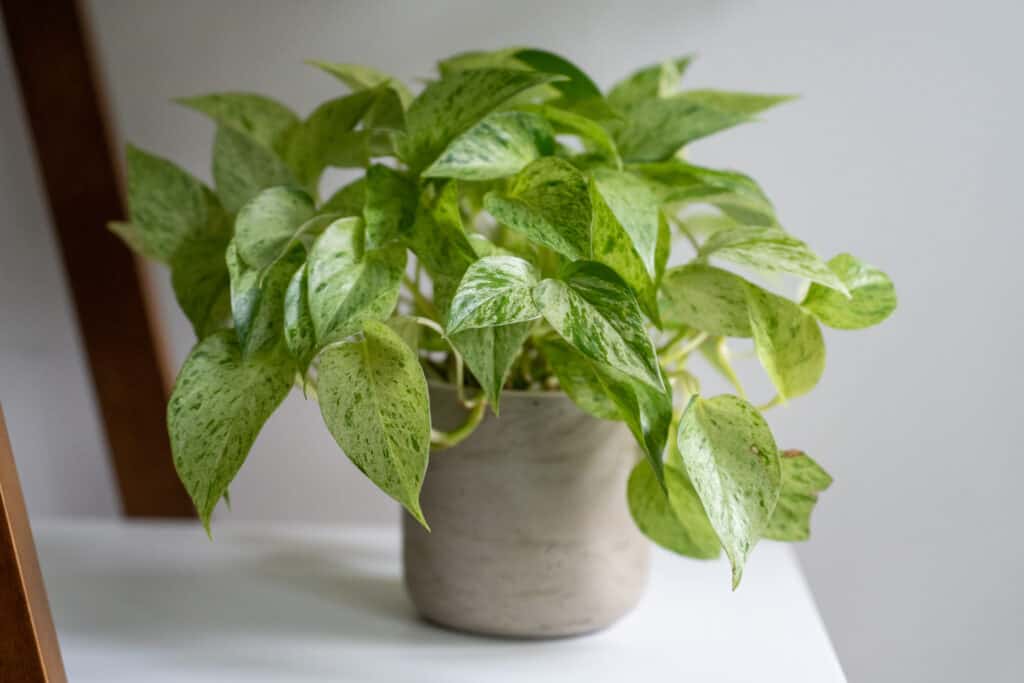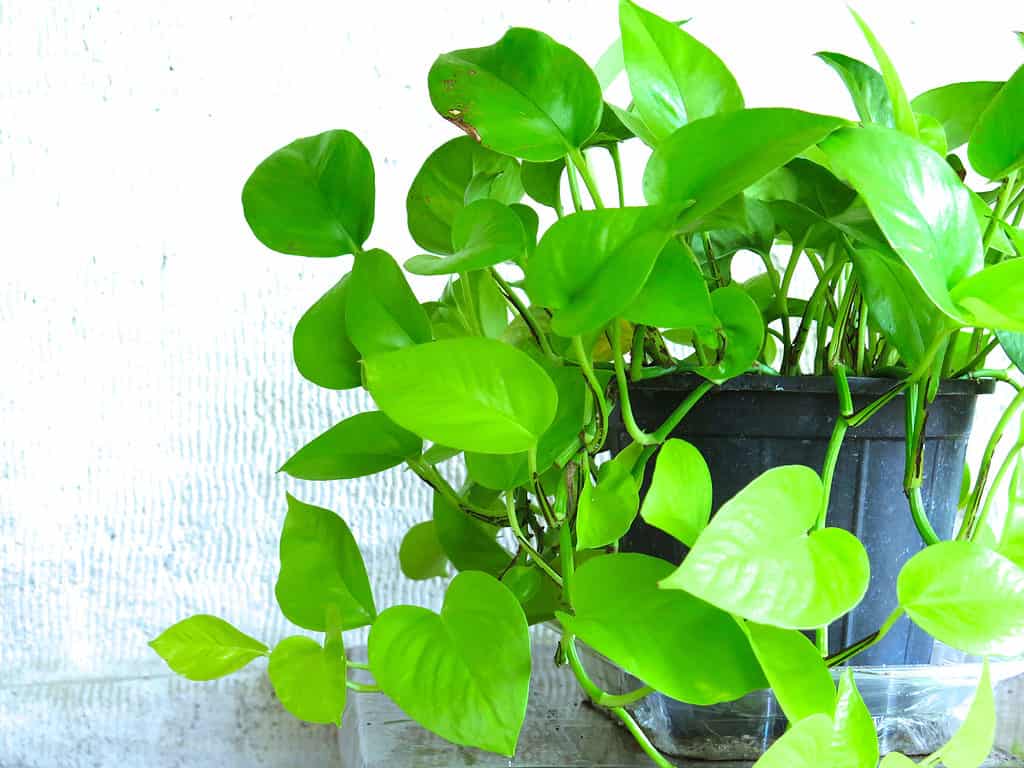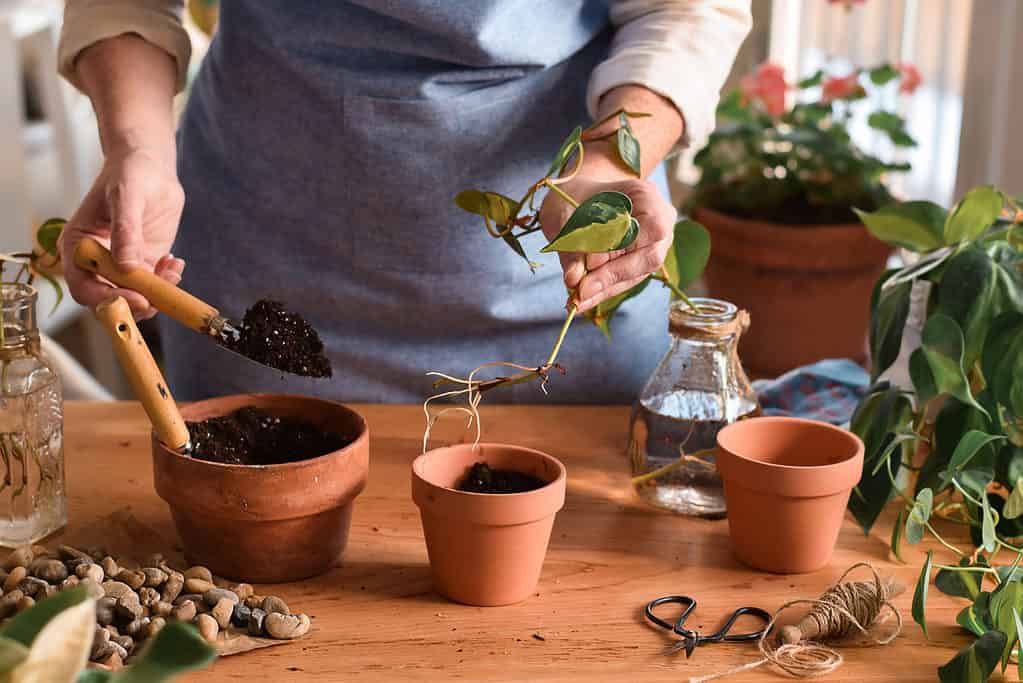If you’re interested in growing indoor pothos, you’ll want to ensure you provide this lovely plant with everything it needs to thrive. When your pothos thrives, it produces stunning foliage and cascading vines. Now, what exactly does pothos need indoors to be happy?
Well, in this guide, we’ll cover everything this indoor perennial plant needs to flourish and grace your space with its beauty.
So, without further ado, let’s jump in!

Pothos also called devil’s ivy, is well-known for being a low-maintenance, resilient plant.
©iStock.com/Jenny Sun
Pothos: Plant Classification
While you may be familiar with pothos as an indoor houseplant, you may not know this plant’s botanical classification or from where it originates. A member of the Araceae family, pothos is a tropical, perennial vine native to the Solomon Islands of the South Pacific. Its botanical name is Epipremnum aureum.
This plant thrives growing in filtered light and the understory of large trees. As it matures, pothos climbs its host tree, gaining more indirect sunlight and growing to massive lengths. At maturity, this stunning variegated plant grows up to 65 feet long. Now, indoors, pothos remains in its juvenile, or vegetative, phase and only grows up to about 10 feet long.

In the wild, pothos climbs its host tree as it matures, gaining more indirect sunlight and growing to massive lengths.
©iStock.com/Suprabhat Dutta
Growing Pothos Indoors: What Does It Need?
To help pothos thrive indoors, it’s important to understand what this plant’s natural habitat is and how to replicate that best indoors. See, as a topical climbing vine, pothos does well in high humidity, warm environments with bright and indirect sunlight (since the sunlight would be filtered through the dense canopy). It prefers moist, well-draining, slightly acidic (6.0-6.5 pH) soil but does not tolerate soggy roots.
One of these plants’ common names is devil’s ivy (even though it’s not a true ivy), because it is well-known for being a low-maintenance, resilient plant. So, you won’t need to sweat too much about providing the exact ideal environment for this plant to grow, but you will see the best results when you provide its ideal conditions.
High Humidity
As a plant native to the tropics that has naturalized to tropical and sub-tropical environments around the world, pothos enjoys high humidity. Its ideal humidity range is 50-70%. In A/C-controlled households, the average indoor humidity typically ranges from 30-50%. In the winter months, the humidity level tends to drop to the lower ends of this range. So when growing indoor pothos, depending on your indoor environment, you may need to give your plant a humidity boost.
One of the easiest ways to ensure that your pothos receives enough humidity in the air is by placing a small humidifier next to your plant. You can set the humidifier a few feet away from your plant and run it for a few hours a day, ideally from morning to midday. If you notice that water is condensing on the leaves of pothos, the humidifier is likely too close to your plant.
Growing Pothos Indoors: Warm Temperatures
To thrive, pothos needs to grow in warm temperatures. Ideally, you should grow pothos indoors in temperatures between 70-90 degrees Fahrenheit. Now, it can survive in lower temperatures down to 50 degrees Fahrenheit, but it will likely not flourish. As such, you won’t see the plant producing full, lovely foliage or growing as fast or strong as it would in its ideal temperature range.
Bright, Indirect Sunlight
You may think this heat-loving plant would happily grow in direct sunlight, basking in the sun’s rays. But in reality, this plant naturally grows in the understory of large tropical trees where it receives medium-to-bright indirect sunlight. Peace lilies are another example of a tropical plant in the Araceae family that thrive in indirect sunlight. When grown in direct sunlight, you’ll often see sunburn damage on pothos’ foliage.
Most pothos cultivars will happily grow in medium-to-bright indirect light. One exception is ‘Neon’ pothos which specifically needs bright indirect sunlight to maintain its vivid yellow-green leaves. If you place pothos in a window, you’ll want to make sure it’s an east or west-facing window, as these directions will decrease the intensity of the sun’s light. Generally, you’ll want to allow pothos to access at least 8 hours per day of indirect sunlight.
Additionally, pothos can grow quite happily in artificial lighting, provided the light intensity is correct. If you provide pothos with an artificial light source between 10,000-20,000 lux, it should be content. Lux is the measurement of the total amount of light that falls on a surface, and you can measure this with a lux meter. Additionally, many artificial lights designed for topical indoor plants include their lux rating on the package.

The ‘Neon’ pothos needs bright indirect sunlight to maintain its vibrant yellow-green leaves.
©M.Sabouri/Shutterstock.com
Growing Pothos Indoors: Well-Draining, Slightly Acidic Soil
As we noted before, pothos is an excellent choice for beginner houseplant growers as it is notably low-maintenance and resilient. Overall, it will grow fine in most soils as long as the plant’s roots do not become soggy. Pothos is much more tolerant of drought than it is soggy roots. So, while it prefers fertile, moist, well-draining, and slightly acidic soil, you’ll want to ensure, first and foremost, that the soil is aerated and well-draining. To fully thrive, it’s important to provide pothos with its ideal soil type. Thankfully, most indoor plant potting mixes are already fairly well-aerated and with additives such as perlite that support drainage. They also tend to be slightly acidic (6.0-6.5 pH), so as long as you confirm these conditions on the package, you’ll probably be safe to use most potting mixes.
Nutrients
Since plants grown indoors don’t grow in soil that is teeming with microbial life responsible for making nutrients in the soil available, you’ll want to add some form of nutrients into the soil. For pothos, you can add a variety of fertilizers, from organic composts to balanced NPK (nitrogen-phosphorus-potassium) mixes. Just make sure to follow the directions for how much to add for your specific fertilizer, and only add them in about every 4-6 weeks during the growing season. When the plant is dormant in the late fall and winter, you’ll want to remove fertilizers as they can cause mineral accumulation damage.
Growing Pothos Indoors: What Pot to Use?
Even if you provide all of the above-mentioned conditions for pothos to thrive, if you use the wrong pot, you may find your plant struggling to flourish. So, what kind of pot is best for pothos? Well, firstly, you’ll absolutely need to make sure the pot has a drainage hole. Perhaps the biggest threat to pothos is root rot from growing in soggy soil. Give your plant its best chance to thrive by planting it in a pot with adequate drainage.
Next, you’ll need to ensure that the plant has enough room to grow without becoming root bound. For pothos, this looks like finding a pot that is about 2 inches wider than the plant’s root mass. This will give the roots adequate room to grow without allowing a too-large mass of soil to accumulate water. As a rapidly growing vine, you’ll want to repot this plant about once a year to ensure it continues to thrive.

It is important to plant pothos in pots with adequate drainage and ample room to grow in order to avoid root problems.
©iStock.com/JulieAlexK
Signs of Root-Bound Pothos
Now, there are signs to look for if you are worried that your pothos may grow in too-small of a container. These signs are:
- Roots growing out of the drainage hole
- Stunted growth
- Yellowing/browning leaves
- Roots pushing emerging from the top of the soil
If you notice any of these signs, it’s definitely time to repot your pothos. You’ll need to be extra gentle in getting your plant out, as the roots will likely have expanded to the edges of the pot. You can often find success in removing a root-bound plant from its pot by first watering it to loosen the soil and root ball, placing the pot upside down, gently grasping the very base of the stem, and wiggling the plant out of the pot. If your root-bound pothos doesn’t want to pop out easily, you can press on the sides of the container (if plastic) to encourage the plant to come free. Or, you can tap the bottom of the container against a hard surface. Once free, massage the root mass to tease apart the root-bound areas and repot gently.
The photo featured at the top of this post is © iStock.com/Firn
Sources
- University of Minnesota Extension, Available here: https://extension.umn.edu/planting-and-growing-guides/lighting-indoor-plants
Thank you for reading! Have some feedback for us? Contact the AZ Animals editorial team.






